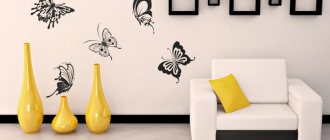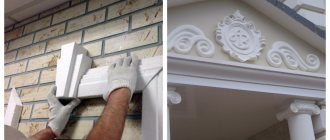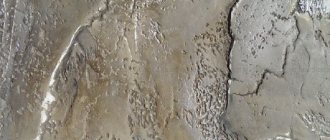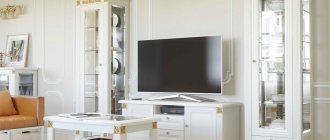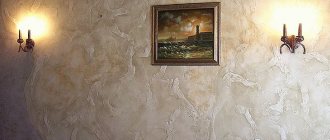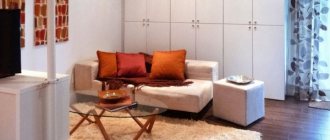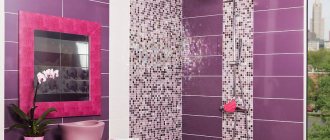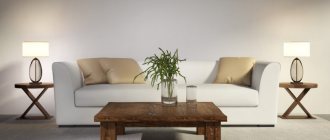Plaster panels in the interior are a common decoration in any architectural style from Ancient Egypt to the most modern high-tech or techno. You can purchase a plaster wall panel ready-made, you can order a unique creation from a decorative artist, but this is quite an expensive pleasure, or you can do the work yourself. Gypsum is a natural, environmentally friendly material that does not cause allergies, is non-flammable and promotes proper moisture exchange in rooms - in the damp season it absorbs moisture, when the air is dry it releases it, and therefore gypsum decor is appropriate in any room. The image motif and scale are selected in accordance with the purpose and size of the room, but the methods for making decorative gypsum panels will remain unchanged.
Gypsum panels for different rooms
A plaster panel can decorate any room, be it a room in a standard apartment, a country mansion, a posh restaurant or the office of a thriving company. You can buy a plaster panel ready-made from a stucco company, or you can make it yourself by choosing the appropriate theme, especially when it comes to decorating your home.
Hall, hallway and corridor
In small rooms, a wall panel can hide some difficult-to-remove defects, disguise a distribution panel, or visually change the space. For entrance rooms in a modern style, 3D relief panels would be appropriate, which are easy to make yourself using ready-made silicone molds.
Relief 3D panels in the interior
Relief 3D panels in the interior
Various wavy or zigzag volumetric panels decorating the end wall of a long corridor will visually shorten it, and the mirror reflection of the panel will give the elongated room more correct proportions.
In a classic interior, panels with typical Empire motifs - vases, bouquets, flower garlands will decorate the entrance to a storage room, technical room or, in a small hallway, decorate a key holder.
Kitchen
The most suitable decor for kitchens:
- casts of vintage utensils - cups, teapots, an interestingly shaped pestle and mortar, an antique beer mug;
- image of fruits and vegetables - root vegetables, pears and apples, pomegranate and bunch of grapes;
- pictures of nature, agricultural work, pastoral scenes.
Volumetric plaster panel depicting fruits
If panels with complex decor are difficult to complete on your own, use a ready-made mold, and you can make casts of vegetables and fruits yourself.
Living room, dining room, family room
It is better to decorate the family space and reception area in the same style as the interior:
- modern style is complemented by 3D panels, three-dimensional paintings of a family tree, landscapes, and three-dimensional flowers.
- classic interiors - small panels in the recreation area, by the fireplace or its imitation;
- historical styles - ancient Egyptian, Greek, Roman - with bas-reliefs of the corresponding style.
- In the dining area, as in the kitchen, a panel depicting still lifes would be appropriate.
Plaster panel in historical style
Having bought one silicone mold with a motif you like, you can decorate the interior with identical panels around the perimeter of the room or group them on one wall - the choice is up to the owners.
Often small panels are installed on the mantelpiece, without fixing them to the wall, or on open furniture shelves - in different lighting conditions, such decorative accents always look new, adding zest to the interior.
Private rooms
The personal space of family members should meet their tastes and hobbies: For kids - anime characters, funny animals, fairy-tale characters; for older children, the decor can be hand-made prints of a herbarium collected in the summer or shells and pebbles brought from a seaside holiday. Making a plaster panel together with your child is a great idea for a weekend.
For the bedroom, we can recommend making more voluminous compositions depicting mythological figures, flowers, and pastoral scenes, but their style, color and size must correspond to the interior of the room.
Plaster panels with abstract compositions, images of animals, landscape views, individual items - pipes for a smoker, weapons for a hunter, a battle scene for a military man, mannequins, vintage clothes for a tailor or fashion designer will find their place in the work rooms.
MOLDED DECOR FROM POLYURETHANE DECOMASTER
The DECOMASTER company produces molded decor from polyurethane, carefully observing the optimal price-quality ratio. If you want to buy stucco decoration inexpensively in Moscow or another city in Russia, this can be done in our stores or on our website. The company's products have all the necessary documents confirming their high quality and safety. We offer you a full range of molded polyurethane products:
- Ceiling cornices;
- Skirting boards;
- Sockets;
- Moldings;
- Wall panels;
- Facade decor;
- Columns, semi-columns and pilasters;
- Frescoes;
- Ornaments;
- Panels and much more.
Molded decorative elements made of polyurethane will help distinguish the design of your house or apartment from a number of similar solutions. The presence of such details in the interior or exterior can radically change the entire appearance of the living space, making it more original and aesthetic. The DECOMASTER company, a manufacturer and expert in the field of integrated interior solutions, presents to your attention a wide selection of high-quality decorative stucco elements made of polyurethane. Take advantage of our offer to create a truly individual design.
ADVANTAGES OF INTERIOR DECOR MADE FROM POLYURETHANE
Stucco molding allows you to add a touch of palace luxury to the interior and implement an unlimited number of interesting design solutions. Currently, such molded elements are made from modern material – polyurethane. This is a universal polymer with many attractive properties. In addition to the affordable cost, its advantages include:
- high degree of detail of elements;
- resistance to mechanical damage;
- durability, resistance to cracking and moisture;
- ease and speed of installation;
- environmental friendliness;
- wide range of color solutions.
WHAT STYLES IS STUCTURE SUITABLE FOR?
Polyurethane stucco is widely used in interiors and exteriors around the world. Most often, stucco is a hallmark of the following styles:
- English,
- Provence,
- classicism,
- neoclassical,
- Art Deco.
For detailed information about which stucco decoration items are characteristic of a particular style, we invite you to familiarize yourself with our catalog at the top of the site
WHY CUSTOMERS CHOOSE OUR PRODUCTS
Design - at the level of art
. Interior style today is a fine line between art, designer work and quality. Only an individual creative approach to each product makes it unique on the market. DECOMASTER company constantly strives for perfection - perfection of style, shape, quality. This is a search that allows you to confidently take a leading position in the decor market and move forward.
Quality is at the level of world standards.
Perfection of form and style requires high quality - this is the basis of modern goods today. DECOMASTER is constantly working to improve the quality of its products and regularly introduces the latest technologies to control it.
Ideal balance of price and quality.
The DECOMASTER company is the largest manufacturer of polyurethane stucco molding in Russia. The scale of production allows us to maintain affordable prices and the level of quality in equal proportions. The company is constantly working on its pricing policy so that you can buy high-quality polyurethane stucco molding at an affordable price. A developed dealer network allows you to buy our products throughout Russia. We have specially developed a system of regular discounts for regular customers.
Stucco decor from DECOMASTER will help you make your interior or exterior perfect and harmonious. Our products are delivered throughout Moscow and other cities.
The elegance of stucco decoration has captured the hearts of people for many centuries. Exquisite ceiling rosettes, luxurious cornices, filigree moldings and slender pilasters give the interior a special chic and respectability. The DECOMASTER company has created for you an extensive collection of stucco decoration made from modern material - polyurethane. It is distinguished by the depth and clarity of the pattern, perfectly smooth surface, and stability of geometric dimensions. Open our catalog and choose stylish decorative stucco molding made of polyurethane!
OUR OFFER
Our assortment includes a wide variety of decor. Here you can choose cornices and moldings, rosettes, columns, wall niches, domes and caissons to decorate the ceiling, and decorative lining for fireplaces. Factory-painted molded elements are included in a separate line. We offer dozens of color options: the charm of white and pastel shades, the nobility of natural wood tones, the luxurious shine of mother-of-pearl, silver and gilding.
The DECOMASTER company has developed thematic collections of polyurethane moldings, where all elements are designed in the same style. It will be easy for our customers to choose the appropriate decor to decorate a classic English interior, a cozy home in the Provence style or luxurious baroque decoration.
PROPERTIES OF POLYURETHANE STUCKING
- Polyurethane stucco molding from DECOMASTER is distinguished not only by its impeccable appearance, but also by its high performance qualities:
- moisture resistance. Polyurethane decor is moisture resistant. You can buy polyurethane stucco molding to decorate the interiors of kitchens, bathrooms, and swimming pools;
- mechanical strength. Polyurethane stucco molding is resistant to mechanical damage: shocks, scratches. Due to its high strength, this decor is suitable for finishing doorways, joints between walls and floors, outer corners of niches and columns;
- ease of installation. Due to their low weight, polyurethane products are easy to transport, store and install. Such stucco molding is securely attached to any surface using special glue;
- many finishing options. Polyurethane is a chemically inert material. Any type of paint can be applied to it: from water-based to nitro enamels. Volumetric decorative elements, such as columns and pilasters, look luxurious when finished with Venetian plaster. In appearance, they are indistinguishable from columns made of natural marble.
FULL SET OF SERVICES: FROM ASSISTANCE IN SELECTION TO INSTALLATION
Our company does everything to make cooperation with us as comfortable and profitable as possible for customers. The list of our services includes:
- consulting support and assistance in choosing suitable polyurethane products for the interior;
- calculation of the required amount of stucco molding and related materials for installation;
- delivery of materials
- stucco decoration installation services.
If we have the goods in stock, we can deliver our stucco molding the next day after ordering.
Our qualified specialists will help you choose products, tell you about all the advantages, features, applications and give recommendations regarding proper installation.
We wish you a pleasant shopping experience,
Sincerely, Decor Center.
How to make a plaster wall panel with your own hands
To make three-dimensional paintings from plaster with your own hands, you will have to equip a workplace, prepare a drawing, tools, materials and be patient. If you have no experience in sculpting or working with plaster, you should try making a small panel to test your strengths and capabilities.
There are several ways to create such art objects:
- casting into ready-made silicone molds;
- casting into custom-made molds;
- creating a three-dimensional plaster panel on the wall according to your own design.
Making a gypsum panel using a ready-made silicone mold
Before making a gypsum panel, we prepare a place: the table must accommodate the product itself, and if it is composed of several elements, also a mold for casting; we need a place to prepare the gypsum mixture, place tools, and materials.
Preparation
The first thing is to prepare the drawing from which the panel will be made. You can download it on the Internet or draw it yourself. If you are planning a panel of vintage items, vegetables, fruits, leaves, prepare them.
To make a gypsum panel you will need materials and tools:
- palette knife, knife, scalpel;
- pencil, ruler;
- sanding paper 150;
- rubber spatula, plank or rule;
- brushes;
- gypsum or gypsum putty;
- water;
- PVA glue to slow down the setting of the composition;
- container for mixing the solution;
- plaster mesh;
- scotch;
- plasterboard in scraps for making molds or ready-made silicone molds;
- liquid nails or special glue;
- dowels (for fastening large heavy panels);
- Vaseline, hand cream or industrial composition for lubricating the mold;
- primer, paint, plaster for finishing - optional.
The work area must be well ventilated.
Preparation of the solution
Since gypsum sets very quickly, the solution should be prepared last, when the place is prepared, all the materials are laid out and the mold or objects for its manufacture are ready.
Water is poured into the container, gypsum powder is introduced into it, stirring constantly, until the solution acquires the consistency of liquid sour cream. To slow down setting, you can add 1-2 tablespoons of PVA glue. The amount of solution must correspond to the volume of the mold. After filling the form, pour out the excess, but not down the drain; it is better to prepare garbage bags or juice packaging (tetra-packs) for this purpose in advance.
Preparing a solution for making gypsum panels with your own hands
Using a silicone mold
Making a plaster panel with your own hands is not difficult if you use ready-made silicone molds - they are sold in abundance at construction markets and in companies dealing with gypsum stucco molding.
Preparation method:
- the silicone or foam mold is lubricated with a special compound, Vaseline or just hand cream - any substance containing fat;
- pour a gypsum solution diluted in water to the consistency of liquid sour cream into the mold;
- Remove air bubbles from the solution with a brush;
- After 2-3 hours, the cast is removed from the mold;
- unevenness is smoothed out with sandpaper;
- if necessary, the impression is tinted and varnished
- the panel is ready.
Making panels from gypsum using a silicone mold
This method is especially good to use if your idea is to create cladding of a large wall with 3D panels: from one mold you can make the required number of elements that are glued to the wall with liquid nails, special glue, or secured with dowels.
It is better to fasten a large panel to the wall with dowels: several holes are drilled in the moistened product, the position of the panel and the mounting holes on the wall is marked, and the corresponding places for the dowels are drilled; then dowel screws are inserted into the holes.
Due to identity, all parts of the composition fit together with virtually no gaps. Small defects and places where dowels are attached can be easily repaired with putty and sanded.
The finished panel is painted with acrylic paint over a primer, and varnished as desired.
Polyurethane decor
The better the design of a home reflects the true passions of the owner, the happier and more harmonious its inhabitants feel. After all, our home is not only the proverbial “fortress”, but also a place where we recharge ourselves with energy for further achievements. If you want your home to bring joy, make it as individual as possible. There are a number of design techniques for this, of which polyurethane decor deserves special attention.
Advantages of using decorative elements made of polyurethane
When describing the “pros” and “cons” of using polyurethane at home, it is worth, first of all, talking about the technical characteristics of the material itself:
- high strength;
- ease;
- flexibility;
- ease of installation (glue, nails);
- high adhesion to any coating;
- high resistance to temperature changes;
- high stability when interacting with water;
- good thermal insulation properties;
- durability (exceeds the durability of wood);
- comparatively cheap.
All of the above characteristics make it possible to use this material absolutely universally: both for interior decoration and for decorating external walls.
Options for using polyurethane decor
Speaking about interior decor made of polyurethane, first of all, I remember its use in classic settings. Traditionally, this style is decorated with plaster stucco, columns and sculptures. However, due to the fragility and high cost of gypsum, an excellent option would be to replace the original stucco with polyurethane decor.
If you want to add individuality to the design of your home, but are not ready to use ceiling or column decor made of polyurethane, for example, false fireplaces are at your service. Made from the same affordable material, they, at the same time, do not introduce a “mothball aroma” and can fit perfectly even into a high-tech style.
In addition, polyurethane will also be useful for those owners who do not intend to radically change the appearance of their home, but want to update some individual elements. For example, old and unattractive portals can be decorated using special polyurethane door decor. At the same time, you can choose suitable shapes from a huge variety of rosettes, sides and moldings, and subsequently paint them in the desired shade. Using the same principle, you can update other furnishings using a wide range of polyurethane furniture decor.
Thus, polyurethane is a material that fully corresponds to the spirit of the times: cheap, high-quality and beautiful. That is why, when decorating your home, you should pay special attention to it: it is quite possible that a polyurethane “touch” will add to the design that touch of individuality that is so necessary for our home.
Making panels in your own mold
If the idea is to create an individual volumetric composition, the work begins with making a mold. This is a more labor-intensive process: you first need to prepare the molds for casting. For example, you want to make a composition of vegetables and fruits for the kitchen, a panel with prints of beautiful autumn leaves for your daughter’s room, a decorative panel with seashells and goldfish for your son, who is passionate about aquariums.
Mold making
To create a decorative plaster panel for the kitchen, we take vegetables - carrots, beets or radishes, onions, garlic, fruits - apple, pear, banana. Each element needs its own container, half filled with bulk material - this could be construction sand, fine cat litter, salt. The container can be made detachable from scraps of drywall, secured with tape - this will make it more convenient to remove the finished cast.
We immerse each object halfway in the sand, lubricate the surface with a fat-containing substance, and fill it with a diluted gypsum composition of the consistency of sour cream in several stages until the object is completely covered with plaster. Don't forget to periodically remove air bubbles. To make the composition set more slowly, you can add a couple of spoons of PVA glue. Before it completely hardens, level the surface of the plaster with a spatula or ruler.
After 2-4 hours, when the mixture has hardened, we disassemble the container, take out the cast, clean the surface of sand, if necessary, add relief to our form, deepening the eyes and veins with some sharp object - a knife, scalpel, screwdriver or chisel. We clean the recess of the mold from dust, grains of sand, cover it with enamel paint or lubricate it with Vaseline. As a result of our efforts, we obtain a mold for casting our vegetable or fruit.
Flowers made of fabric or foamiran can be used as the basis for flower petals. The mold for casting leaves and the leaves themselves are made similarly to the molds and castings of vegetables and fruits, and fabric decorative flowers of the required size must be disassembled into their component elements, each of them dipped into a plaster solution or carefully applied with a brush, without leaving any unpainted marks, dried, and painted. From the prepared elements, assemble a composition, securing it to the wall with liquid nails or special glue. The finished composition is primed and painted.
Casting of individual parts of the decor
We pour gypsum mortar into the prepared form, get rid of the air, and smooth the surface to the level of the top of the form. After 2 hours, when the casting has hardened, it can be removed from the mold and any existing defects can be eliminated. In the same way, we cast the halves of all the vegetables and fruits needed for the composition.
This method is suitable for making blanks for decoration of any theme: shells, leaves, flower petals.
Assembling the composition
We are preparing a frame for our art object - it can be a ready-made plaster molding or a cornice strip or glazing bead. The basis of the panel can be a sheet of plasterboard or chipboard, fabric, or a self-made gypsum panel.
You can simply glue our castings onto a plasterboard or chipboard base using liquid nails or Moment glue, and then paint and varnish the entire product.
Finished gypsum panel
Panel with woven decor
Using decorative fabrics for the base requires caution: the direction of the threads must be observed to avoid distortion of the pattern. A piece is cut out of the fabric to the size of the base tablet made of plasterboard, chipboard or moisture-resistant plywood, plus an allowance for thickness and hem. The tablet is coated with PVA glue, and decorative fabric is stretched over it.
The tension should be uniform; air bubbles should be expelled with a rubber spatula and folds should be smoothed out if the fabric has a pattern. Plain decorative fabrics with a sparse interweaving of threads can be laid on a tablet, creating a pattern of folds and creases - this technique is suitable for creating compositions of flowers or vintage figures of people.
Gypsum panel
A more complex method is to make a gypsum panel. To do this, we provide the base sheet with sides, lubricate the resulting pallet with Vaseline or cream, fill in the gypsum composition, embed a plastic mesh into it for reinforcement, again pour the gypsum solution in layers until a panel is 3-4 cm thick or to the height of the sides, level the surface along the long sides ruler or plaster rule.
We lay out the panel blanks on the panel according to a pre-prepared pattern and fill in the solution, remove the air, level it - we get three-dimensional gypsum panels. We carry out the final finishing: until the mixture has completely hardened, you can deepen the relief, smooth out unevenness, repair defects, if desired, you can make the base in relief using an imprint of a plaster mesh, a roller with a pattern, a textured fabric with an interesting interweaving of threads. But most often in interiors snow-white plaster with acrylic painting and varnish is used.
Installation of panels on the wall
A small finished panel can be fixed to the wall using liquid nails; larger and heavier ones can be attached to dowels. It is better to use dowel screws to avoid chipping the surface.
The panel can be framed with a molding or cornice made of gypsum stucco, or a wooden bead painted to match the color of the product or a contrasting color. In a modern interior, a voluminous wide frame in a contrasting color of small art objects is often used. A composition of several panels of different shapes and sizes will always attract attention.
Stucco molding in the kitchen interior
In most cases, stucco molding has associations with luxurious and chic interiors of old houses, where representatives of the aristocracy used to live. Now this decorative element can be successfully used in modern kitchens, because it is made from materials that are considered quite affordable. Today's stucco decor is made from materials such as polyurethane or ordinary plaster.
Polyurethane products are considered the best option for decorating kitchen interiors because they are lightweight, resistant to moisture, deformation, strong and will not absorb odors. It is also worth saying that they are easy to install and much cheaper in price. Now manufacturers recommend a large selection of very different stucco decoration elements. These are borders, rosettes, baseboards and moldings, pilasters, domes, cornices and other products.
Very often, stucco ceiling molding is used in the kitchen area. It not only gives the room a more beautiful and magnificent look, but also makes it possible to hide many of the imperfections of the cladding, and is also used to install hidden lighting. Coffered stucco ceilings look great in large kitchens, creating an atmosphere of luxury and conviviality. To decorate the walls, cornices with different patterns are used, hiding inaccuracies in the cladding and giving the interior a well-groomed and complete look. Wall planes decorated with stucco columns or pilasters look quite elegant and noble.
If you wish, in the kitchen area you can decorate doorways, arches with stucco, and also decorate bay windows and niches with them. You need to know that stucco molding is not suitable for every designer’s decision. It will look great in kitchens made in similar styles as Rococo, Baroque, Classic, as well as in ancient interiors. It is ideal for rooms decorated in the Arabic style, which in their appearance resemble chic harems. All stucco details should be in perfect harmony with the color palette in which the room is decorated, as well as with furniture and finishing materials.
Such kitchens must have luxurious furniture made from expensive materials, because inexpensive products will not correspond to the overall design. You should not decorate kitchens that have a small area with stucco, because in similar rooms it will look pretentious and inappropriate. It is also worth saying that, visually, this kind of room will seem much smaller and too large. Before decorating the ceiling with stucco, you should make sure that it has the required height, otherwise it will seem too low and visually oppressive from above.
Stucco decor does not have to be white. Now most companies make products that have the shade of real materials, for example, ivory, marble or different types of wood. Such components have a very high cost, but look strikingly stylish and magnificent in design.
Beams and stucco in the interior: we create a unique interior!
Making a plaster painting with your own hands
If you have drawing and sculpting skills, then you will be able to create a picture on the wall. Here you can use several working methods at once and combine them with each other.
To create the composition, gypsum putty is used. It is more viscous, does not flow, and hardens more slowly.
According to the drawing transferred to the wall, gypsum putty is applied layer by layer and a palette knife, knife or scalpel is used to give it the desired shape and volume. If a high volume is required, for example, it is necessary to depict a tree trunk, you can use ropes made of synthetic fibers, blanks of plasterboard or PVC pipes glued to the wall as a frame, and then reinforce the frame with a plaster mesh embedded in the same putty.
A composition for a bedroom with images of large flowers and leaves can be made using pre-cast blanks, the shape of which can be large dense leaves of domestic plants - sanseveria (popularly called pike tail or mother-in-law's tongue), monstera, varieties of ficus, and the petals - lilies, irises made from fabric.
Example of a plaster panel on the wall
The painting can be framed by a plaster molding or a cornice secured with dowels; compositions that occupy the entire wall, or even extend to other surfaces, do not need framing, and do not require coloring.
Decorative finishing of gypsum panel
You can decorate a gypsum panel with your own hands with gilding, silvering, decorative plaster, or artificially age it.
The simplest type of finishing of gypsum stucco is painting over a primer with snow-white acrylic paint containing marble dust and wax particles. This way, a plaster panel will get a lotus effect - repelling dust and dirt, and reflective marble dust particles will give the surface a glowing effect.
A more complex type of decor is patination: the tinted plaster along the edges and convex parts is painted in a slightly darker shade or covered with gold or silver paint, then the decorative layer is partially removed with sandpaper, and the panel is varnished.
A gypsum panel can be finished with decorative mineral roll plaster, painted with multi-layer compositions, for example, to imitate fallen leaves, 3-4 shades in a yellow-brown range are used, while it is easier to start with the lightest tone:
- cover the entire workpiece with yellow paint;
- when it dries, apply orange paint to the areas closer to the edges of the sheet;
- when it dries, smooth the edge of the junction of flowers with sandpaper;
- apply a terracotta shade to the edges of the leaf;
- smooth the border again;
- draw the veins with brown paint;
- cover the product with a layer of varnish.
Flower decor with color transitions is made according to the same principle.
Decorated plaster panel
Decorated plaster panel
